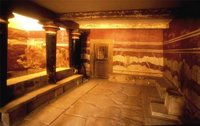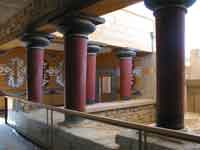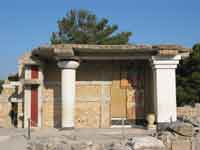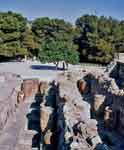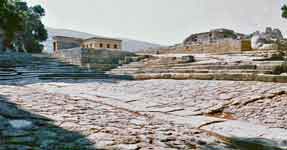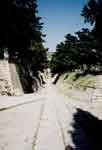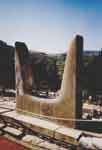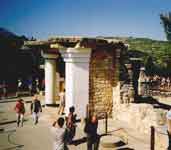.
Periphery: Crete
Prefecture : Heraklion
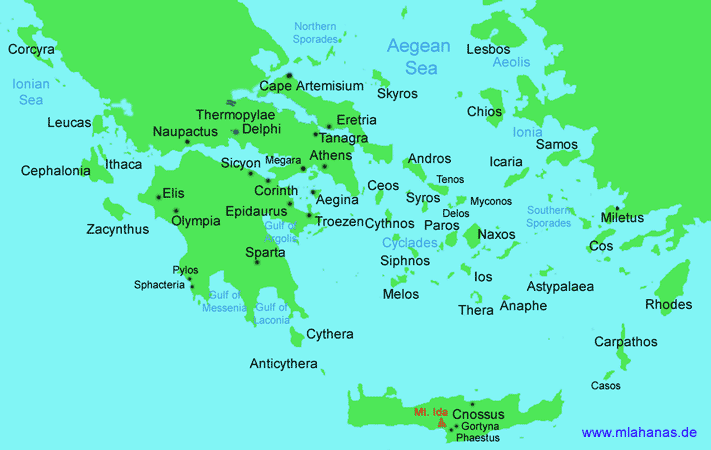
Knossos (alternative spellings Knossus, Cnossus, Gnossus, Greek Κνωσσός) is the largest Bronze Age archaeological site on Herakleion, Crete, probably the ceremonial and political center of the Minoan culture.
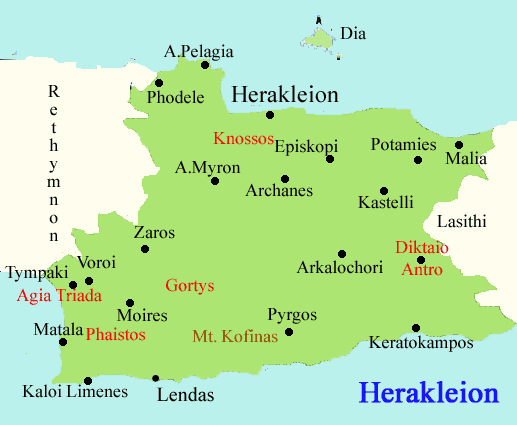
Knossos in the Herakleion Prefecture
Knossos, also known by its romantic name of the Palace of Minos, was discovered by Sir Arthur Evans in 1894. However, the civil war in Crete against the Turks intervened, and it was not until March 16, 1900 that Evans was able to purchase the entire site and conduct massive excavations. Assisted by Dr. Duncan Mackenzie, who had already distinguished himself by his excavations on the island of Melos, and Mr. Fyfe, the British School of Athens architect, Evans employed a large staff of excavators and by June of 1900 had uncovered a large portion of the palace.
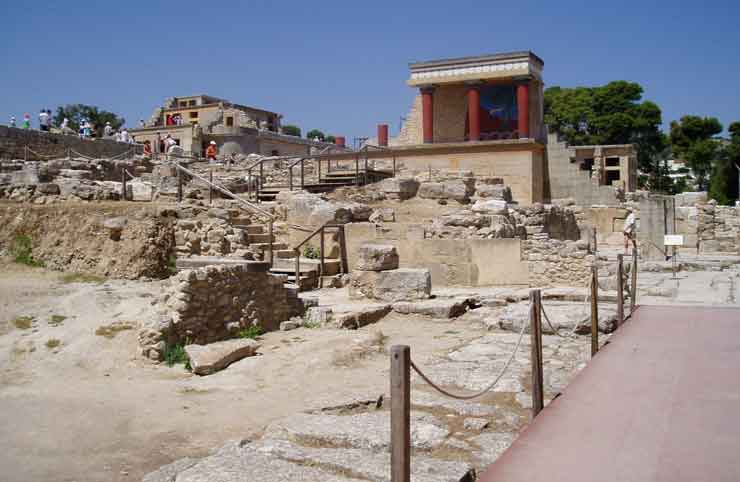
The site has a very long history of human habitation, beginning with the founding of the first Neolithic settlement in ca. 7000 BC . Over time and several different phases of growth that had their own social dynamic, Knossos grew in size until, by the 19th to 16th centuries BC (during the 'Old Palace' and the succeeding 'Neo-palatial' periods), the settlement possessed monumental administrative and religious central building (i.e., the Palace) but also a surrounding settlement of 5000-8000 people. A long-standing debate between archaeologists is whether the Palace acted primarily as an administrative or religious center (or, more likely, was a combination of both in a theocratic manner). Other important debates consider the role of Knossos in the administration of Bronze Age Crete, and whether Knossos acted as the primary center, or was on equal footing with the several other contemporary palaces that have been discovered on Crete. Many of these palaces on Crete were destroyed and abandoned in the early part of the 15th century BC, possibly by the Mycenaeans, although Knossos remained in use until destroyed by fire about one-hundred years later.
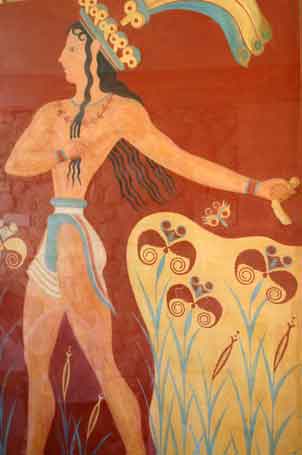
Knossos mural, the so called 'Prince with the Lilies' or 'Priest King' Fresco (Knossos, c. 1500 BC)
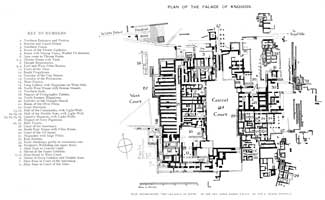
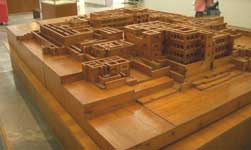
Knossos Palace, Reconstruction

Jar from Knossos

Knossos, Drain Pipes
One of the more remarkable discoveries at Knossos was the extensive murals that decorated the plastered walls. All were very fragmentary and their reconstruction and re-placement into rooms by the artist Piet de Jong is not without controversy. These sophisticated, colorful paintings portray a society who, in comparison to the roughly contemporaneous art of Middle and New Kingdom Egypt, are conspicuously non-militaristic. In addition to scenes of women and men linked to activities like fishing and flower gathering, the murals also portray athletic competitions, likely of a ritual nature, in which youths performed daring acrobatics on the backs of charging bulls.
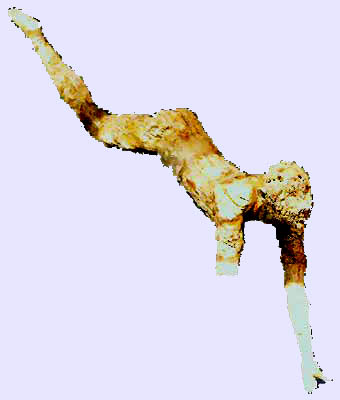
The Bull Leaper, an ivory figurine from the palace of Cnossus. The only complete surviving figure of a larger arrangement of figures. This is the earliest three dimensional representation of the bull leap. It is assumed, that thin gold wires were used to suspend the figure over a bull.
|
Ariadne's throne |
The centerpiece of the palace was the so-called Throne Room. This chamber has a dramatic chair built into the wall, facing a number of benches. This room has a tank which it is speculated was used as an aquarium.
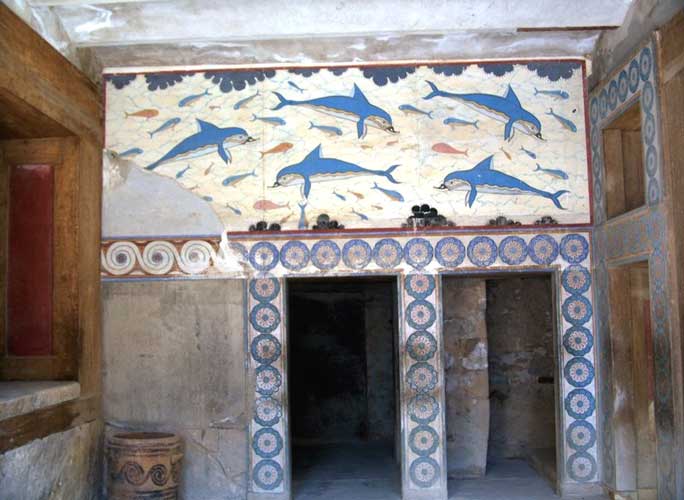
Fresco with Dolphins
Other parts of this extremely large palace include spacious apartments with running water in terra-cotta pipes, flush toilets; long halls with storerooms containing huge ceramic jars used to store grain; the world's earliest-known amphitheater with tiers of stone steps seating 200, and religious shrines. The palace is about 130 meters on a side and since the Roman period has been associated as the source of the myth of the Labyrinth.
See also

Blue Bird, House of Frescoes |
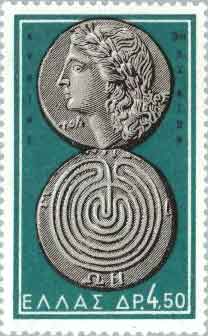
3rd BC Tetradrachm Coin from Crete, Apollo with the inscription (ΠΟΛΧΟΣ ) Polhos and a circular Labyrinth with the inscription (ΚΝΩΣΙΩΝ) Cnossus |

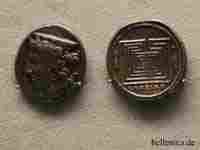
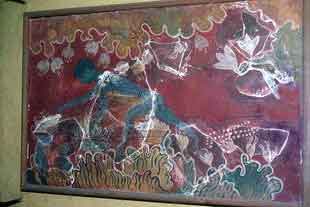
This ancient Minoan fresco from the palace of Knossos was originally erroneously restored by Sir Arthur Evans as a blue-skinned boy gathering saffron, as depicted here. The fresco was later shown in fact to depict a saffron-gathering monkey. (Image Source)
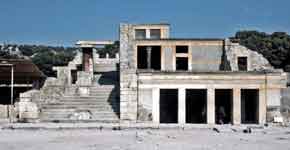 |
|
- The Palaces of Minos at Knossos
- British School at Athens Knossos Pages (http://www.bsa.gla.ac.uk/knossos)
- Aegean Prehistory Online at Dartmouth (http://projectsx.dartmouth.edu/history/bronze_age)

Greece :
A - B - C - D - E - F - G - H - I - J - K - L - M -
N - O - P - Q - R - S - T - U - V - W - X - Y - Z
| Ancient Greece
Science, Technology , Medicine , Warfare, , Biographies , Life , Cities/Places/Maps , Arts , Literature , Philosophy ,Olympics, Mythology , History , Images Medieval Greece / Byzantine Empire Science, Technology, Arts, , Warfare , Literature, Biographies, Icons, History Modern Greece Cities, Islands, Regions, Fauna/Flora ,Biographies , History , Warfare, Science/Technology, Literature, Music , Arts , Film/Actors , Sport , Fashion --- |
Retrieved from "http://en.wikipedia.org/"
All text is available under the terms of the GNU Free Documentation License



